Themed collection Chemosensors and Molecular Logic

Stochastic pumping of non-equilibrium steady-states: how molecules adapt to a fluctuating environment
Fluctuations favour state B = (B,B′) based on kinetic asymmetry combined with moderate dissipation rather than state A = (A,A′) in which the absolute amount of dissipation is greater but where there is no kinetic asymmetry.
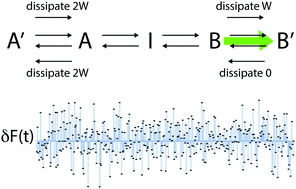
Chem. Commun., 2018,54, 427-444
https://doi.org/10.1039/C7CC06683J
Intracellular temperature measurements with fluorescent polymeric thermometers
Intracellular temperature can be measured using fluorescent polymeric thermometers via their temperature-dependent fluorescence signals.
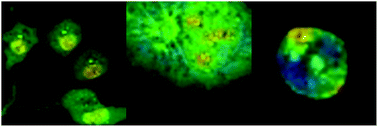
Chem. Commun., 2017,53, 10976-10992
https://doi.org/10.1039/C7CC06203F
Fluorescent glycoprobes: a sweet addition for improved sensing
We highlight recent progress from our labs for the development of fluorescent glycoprobes for sensing ions/lectins and targeted detection of intracellular species, including the construction of their 2D material composites for targeted fluorescence imaging and theranostics.
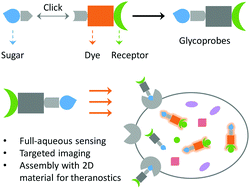
Chem. Commun., 2017,53, 82-90
https://doi.org/10.1039/C6CC06875H
Molecular logic gates: the past, present and future
Molecular logic gates, now with more than two decades of collective exploration, are poised for practical applications.
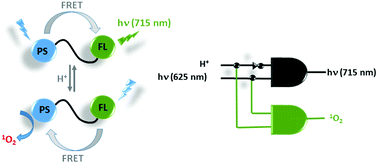
Chem. Soc. Rev., 2018,47, 2228-2248
https://doi.org/10.1039/C7CS00491E
Fluorescent chemosensors: the past, present and future
Fluorescent chemosensors for ions and neutral analytes have been widely applied in many diverse fields such as biology, physiology, pharmacology, and environmental sciences.
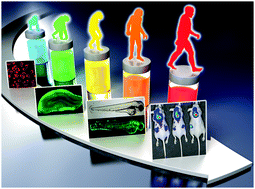
Chem. Soc. Rev., 2017,46, 7105-7123
https://doi.org/10.1039/C7CS00240H
pH-Sensing fluorescence oligonucleotide probes based on an i-motif scaffold: a review
Fluorescent i-motif based sensors as promising tools for cellular pH-sensing and bioimaging.
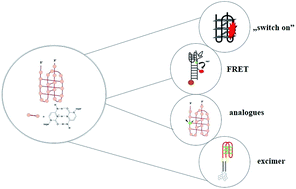
Anal. Methods, 2017,9, 6092-6106
https://doi.org/10.1039/C7AY01942D
Lighting-up protein–ligand interactions with fluorescent PET (photoinduced electron transfer) sensor designs
Extending the versatile fluorescent PET sensing/switching system causes ‘off–on’ signalling when a ligand binds to its appropriate protein.
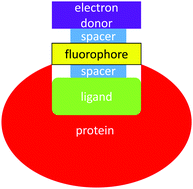
Chem. Commun., 2018,54, 1319-1322
https://doi.org/10.1039/C7CC05929A
Monitoring of Au(III) species in plants using a selective fluorescent probe
A colorimetric and ratiometric probe with a push–pull chromophore dicyanoisophorone system, AuP, has been developed for the detection of Au(III) species with highly sensitive and selective response to real-water samples and living tissues of Arabidopsis thaliana.

Chem. Commun., 2018,54, 888-891
https://doi.org/10.1039/C7CC08333E
Sensing the impact of environment on small molecule differentiation of RNA sequences
Pattern recognition of RNA with small molecules (PRRSM) reveals the impact of environmental conditions on the differentiation of RNA structures.
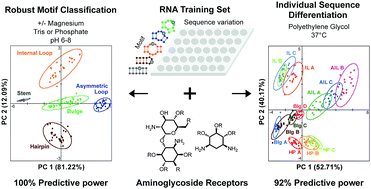
Chem. Commun., 2017,53, 13363-13366
https://doi.org/10.1039/C7CC07157D
A multifunctional logic gate by means of a triple-chromophore fluorescent biothiol probe with diverse fluorescence signal patterns
Multiple logic gates such as OR, TRANSFER, INH, NOT, and YES operations were achieved on a single triple-chromophore fluorescent probe by using biothiols and fluorescence signal patterns as the multiple inputs and outputs.

Chem. Commun., 2017,53, 13168-13171
https://doi.org/10.1039/C7CC07296A
Folded short azapeptide for conformation switching-based fluorescence sensing
Dipeptide-based amidothiourea (azapeptides) bearing folded β-turn structures were employed to build beacon-like fluorescent sensors signalled by pyrene exciplex or excimer dual emission to allow highly sensitive ratiometric fluorescence sensing of an anion able to bind to the structural moiety placed within the turn structure.
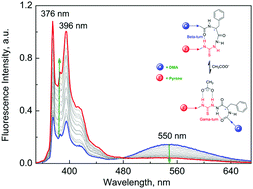
Chem. Commun., 2017,53, 13137-13140
https://doi.org/10.1039/C7CC06915D
Long-wavelength fluorescent boronate probes for the detection and intracellular imaging of peroxynitrite
Two boronate fluorescent probes have been developed for the detection of peroxynitrite (TCFB1 and TCFB2).
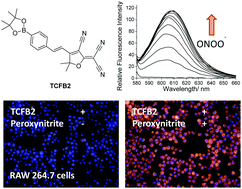
Chem. Commun., 2017,53, 12822-12825
https://doi.org/10.1039/C7CC07845E
A continuous luminescence assay for monitoring kinase activity: signalling the ADP/ATP ratio using a discrete europium complex
A stable Eu(III) complex is reported that binds reversibly to ATP and ADP, providing a ratiometric luminescent signal that enables the kinase-catalysed conversion of ATP to ADP to be monitored in real-time.
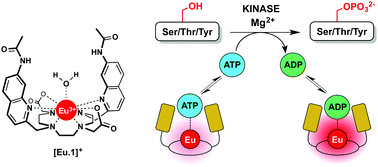
Chem. Commun., 2017,53, 12626-12629
https://doi.org/10.1039/C7CC05887J
A naphthalimide-based solid state luminescent probe for ratiometric detection of aluminum ions: in vitro and in vivo applications
A naphthalimide-based solid state luminescent probe has been designed and synthesized for the detection of Al3+ ions in solution as well as in the solid state with its versatile applications as materials and as a bio-imaging tool for the detection of Al3+ ions under in vitro and in vivo milieu.
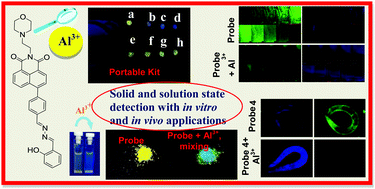
Chem. Commun., 2017,53, 12646-12649
https://doi.org/10.1039/C7CC07996F
Azulene–boronate esters: colorimetric indicators for fluoride in drinking water
Sensitive and selective fluoride indicators consisting of a boronate ester receptor motif, conjugated to an azulene reporter motif, are described. These exhibit a colour change visible to the naked eye when exposed to fluoride.

Chem. Commun., 2017,53, 12580-12583
https://doi.org/10.1039/C7CC07416F
Supramolecular coordination polymers using a close to ‘V-shaped’ fluorescent 4-amino-1,8-naphthalimide Tröger's base scaffold
A novel 4-amino-1,8-naphthalimide derived Tröger's base ligand L has been synthesised and subsequently used in the formation of two new supramolecular coordination polymers TB-Co-CP and TB-Cd-CP.
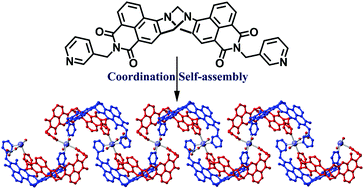
Chem. Commun., 2017,53, 12512-12515
https://doi.org/10.1039/C7CC07333J
Protein sensing and discrimination using highly functionalised ruthenium(II) tris(bipyridyl) protein surface mimetics in an array format
Ruthenium(II) tris(bipyridyl) protein surface mimetics are used for protein sensing in an array format.

Chem. Commun., 2017,53, 12278-12281
https://doi.org/10.1039/C7CC06175G
Modular synthesis of 4-aminocarbonyl substituted 1,8-naphthalimides and application in single molecule fluorescence detection
Robust 1,8-naphthalimide cross-coupling methodology unlocks access to derivatives with interesting photophysical properties and diverse applications.
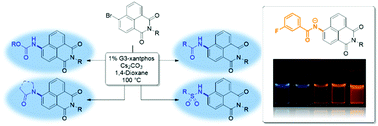
Chem. Commun., 2017,53, 12298-12301
https://doi.org/10.1039/C7CC07922B
Selenoureas for anion binding as molecular logic gates
The first example of a molecular logic gate based on selenourea/anion host–guest interaction that performs a ternary logic operation using an 1H-NMR easy to read response output is described here.

Chem. Commun., 2017,53, 11869-11872
https://doi.org/10.1039/C7CC07148E
A highly selective fluorescence turn-on detection of ClO− with 1-methyl-1,2-dihydropyridine-2-thione unit modified tetraphenylethylene
A novel fluorescent probe for ClO− is developed by the combination of a new ClO− responsive unit and the aggregation induced-emission feature of tetraphenylethylene.

Chem. Commun., 2017,53, 11654-11657
https://doi.org/10.1039/C7CC07092F
A mechanistically-distinct approach to fluorescence visualization of singlet oxygen
1O2 oxidation of a non-fluorescent sulfoxide forms a fluorescent sulfone, with significant (>50-fold) increase in emission. The oxidation occurs via intramolecular oxygen atom transfer from a reactive persulfoxide intermediate. This represents a new, mechanistically-distinct approach to fluorescent 1O2 detection.
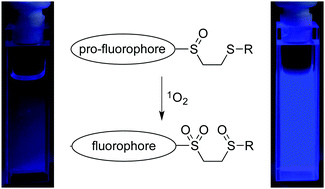
Chem. Commun., 2017,53, 11449-11452
https://doi.org/10.1039/C7CC06214A
Lysosomal tracking with a cationic naphthalimide using multiphoton fluorescence lifetime imaging microscopy
A naphthalimide-based chemosensing motif capable of turning on the fluorescence emission in solution and in vitro is reported.
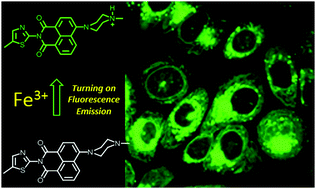
Chem. Commun., 2017,53, 11161-11164
https://doi.org/10.1039/C7CC05166B
Enhanced detection of explosives by turn-on resonance Raman upon host–guest complexation in solution and the solid state
Being colour coordinated allows turn on detection of nitroaromatics by combining molecular recognition with resonant enhancement of the Raman spectra.
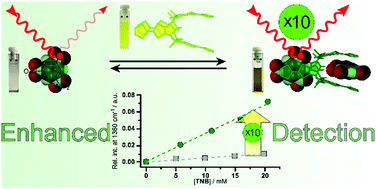
Chem. Commun., 2017,53, 10918-10921
https://doi.org/10.1039/C7CC06517E
TPZ, a bright centrosymmetric two-photon scaffold for bioimaging
The development of biocompatible two-photon fluorophores with a large absorption cross-section is challenging, despite the presence of theoretical guidelines.
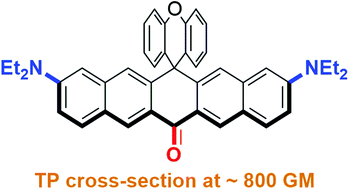
Chem. Commun., 2017,53, 10938-10941
https://doi.org/10.1039/C7CC06031A
A two-photon fluorescent probe for ratiometric imaging of endogenous hypochlorous acid in live cells and tissues
A fluorescent probe enables two-photon ratiometric imaging of endogenous hypochlorous acid, a reactive oxygen species, in cells and tissues.
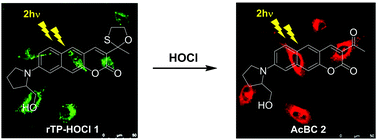
Chem. Commun., 2017,53, 10800-10803
https://doi.org/10.1039/C7CC05834A
Dibenzazepinyl ureas as dual NMR and CD probes of helical screw-sense preference in conformationally equilibrating dynamic foldamers
Dibenzazepinyl ureas act as probes to allow conformational analysis of screw-sense preference in dynamic foldamers by both NMR and CD spectroscopy.
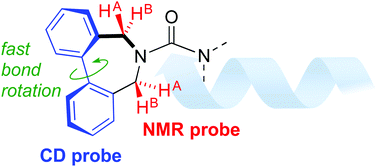
Chem. Commun., 2017,53, 10768-10771
https://doi.org/10.1039/C7CC06427F
Two fluorescein-based chemosensors for the fast detection of 2,4,6-trinitrophenol (TNP) in water
Two fluorescein-based chemosensors have been developed for the rapid and selective fluorescence detection of 2,4,6-trinitrophenol (TNP) under excitation by visible light.
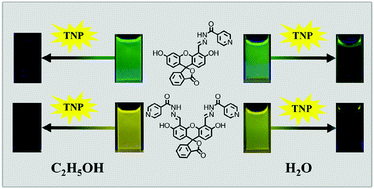
Chem. Commun., 2017,53, 10524-10527
https://doi.org/10.1039/C7CC05966C
Rational design of a fast and selective near-infrared fluorescent probe for targeted monitoring of endogenous nitric oxide
We developed a fast and selective near-infrared (NIR) fluorescent probe for the targeted tracing of endogenous NO which possesses vital features including a significant turn-on NIR response, high specificity, and a fast response.

Chem. Commun., 2017,53, 10520-10523
https://doi.org/10.1039/C7CC05971J
A bodipy based hydroxylamine sensor
With this research we have developed a bodipy based system as the first “turn-on” fluorescence system for the detection hydroxylamine.
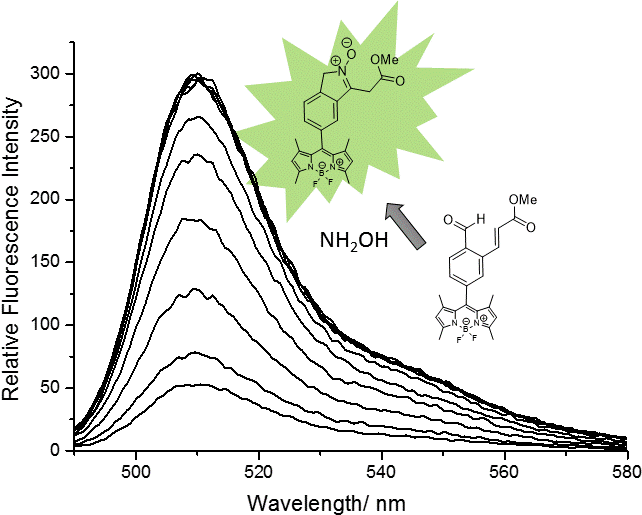
Chem. Commun., 2017,53, 10441-10443
https://doi.org/10.1039/C7CC05872A
Fluorescent chirality recognition by simple boronate ensembles with aggregation-induced emission capability
Chiral boronate ensembles showed enantioselective aggregation behaviors for chiral diamines and cinchona alkaloids, enabling the fluorescent recognition of their chirality.
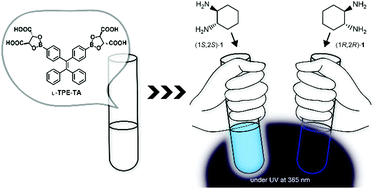
Chem. Commun., 2017,53, 10144-10147
https://doi.org/10.1039/C7CC05784A
Ratiometric electrochemical detection of β-galactosidase
A novel ferrocene-based substrate for the ratiometric electrochemical detection of β-galactosidase was designed and synthesised, exhibiting high sensitivity for β-gal.
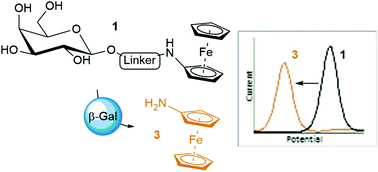
Org. Biomol. Chem., 2017,15, 7122-7126
https://doi.org/10.1039/C7OB01593C
An AIE-based fluorescent test strip for the portable detection of gaseous phosgene
An AIE-based ratiometric fluorescent test strip was developed for portable point-of-use detection of gaseous phosgene.
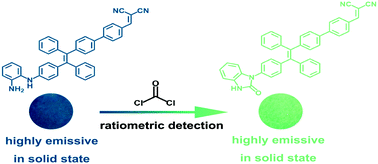
Chem. Commun., 2017,53, 9813-9816
https://doi.org/10.1039/C7CC05313D
Supramolecular core–glycoshell polythiophene nanodots for targeted imaging and photodynamic therapy
We show that supramolecular core–glycoshell nanodots are capable of targeted imaging and photodynamic therapy of liver and triple-negative breast cancer cells.
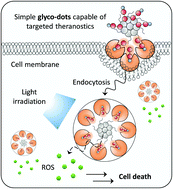
Chem. Commun., 2017,53, 9793-9796
https://doi.org/10.1039/C7CC04525E
Acid/base-controllable fluorescent molecular switches based on cryptands and basic N-heteroaromatics
Two kinds of fluorescent BMP32C10-based cryptands 1 and 2 have been developed.

Chem. Commun., 2017,53, 11838-11841
https://doi.org/10.1039/C7CC07469G
Photochromism and molecular logic gate operation of a water-compatible bis-glycosyl diarylethene
The synthesis of a bis-glycosyl diarylethene derivative by click chemistry for the water-compatible photochromism and operation of molecular logic gates is reported.
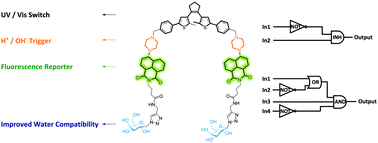
Chem. Commun., 2017,53, 9494-9497
https://doi.org/10.1039/C7CC04427E
Proof of principle of a three-input AND–INHIBIT–OR combinatorial logic gate array
A designed molecule provides a fluorescent signal according to a combinatorial logic array comprised of three-input AND, three-input INHIBIT and two-input OR logic gates.
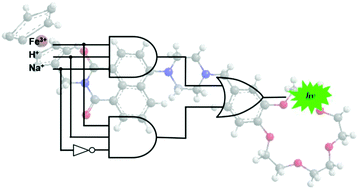
Org. Biomol. Chem., 2017,15, 6706-6709
https://doi.org/10.1039/C7OB01223C
One-step, green synthesis of a supramolecular organogelator based on mellitic triimide for the recognition of aromatic compounds
Mellitic triimide derivatives act as supramolecular gelators, which enable the detection of aromatic molecules as a gel–sol phase transition.

Chem. Commun., 2017,53, 8834-8837
https://doi.org/10.1039/C7CC04876A
2-Nitroimidazole based fluorescent probes for nitroreductase; monitoring reductive stress in cellulo
Two 2-nitroimidazole-1,8-naphthalimide conjugates, 1 and 2, have been synthesised as fluorescence probes for the detection of reductive stress in HeLa cells.
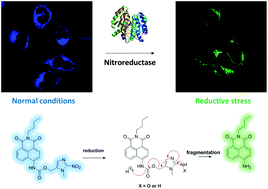
Org. Biomol. Chem., 2017,15, 6104-6108
https://doi.org/10.1039/C7OB01406F
A redox-responsive selenium-containing pillar[5]arene-based macrocyclic amphiphile: synthesis, controllable self-assembly in water, and application in controlled release
A selenium-containing pillar[5]arene-based macrocyclic amphiphile was prepared. This amphiphile self-assembled in water to form vesicles with redox responsiveness. Then, these pillar[5]arene-based vesicles were used in the controlled release of DOX.
![Graphical abstract: A redox-responsive selenium-containing pillar[5]arene-based macrocyclic amphiphile: synthesis, controllable self-assembly in water, and application in controlled release](/en/Image/Get?imageInfo.ImageType=GA&imageInfo.ImageIdentifier.ManuscriptID=C7CC04779G&imageInfo.ImageIdentifier.Year=2017)
Chem. Commun., 2017,53, 8364-8367
https://doi.org/10.1039/C7CC04779G
Selectively switching on europium emission in drug site one of human serum albumin
A luminescent europium probe has been discovered that binds selectively to drug-site I in human serum albumin, signalled by a ‘switching on’ of europium emission, and accompanied by strong induced circularly polarised luminescence.
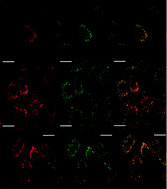
Chem. Commun., 2017,53, 6724-6727
https://doi.org/10.1039/C7CC03071A
A molecular self-assembled colourimetric chemosensor array for simultaneous detection of metal ions in water
An easy-to-prepare chemosensor assay based on molecular self-assemblies of 3-nitrophenylboronic acid and catechol dyes can detect metal ions qualitatively and quantitatively.
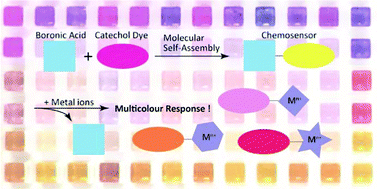
Chem. Commun., 2017,53, 6561-6564
https://doi.org/10.1039/C7CC03218H
A wash-free SNAP-tag fluorogenic probe based on the additive effects of quencher release and environmental sensitivity
A 1,8-naphthalimide-derived SNAP-tag fluorogenic probe can specifically and rapidly label proteins in live cells without requiring a wash procedure.

Chem. Commun., 2017,53, 6448-6451
https://doi.org/10.1039/C7CC01483J
Visualization of vesicular transport from the endoplasmic reticulum to lysosome using an amidine derived two-photon probe
An amidine-based small molecule two-photon fluorescent probe for monitoring vesicle transport from the ER to lysosome in live cells was reported.
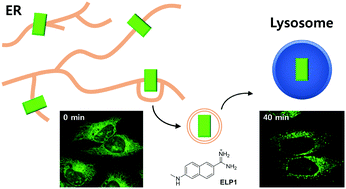
Chem. Commun., 2017,53, 6097-6100
https://doi.org/10.1039/C7CC01518F
A tumor-specific and mitochondria-targeted fluorescent probe for real-time sensing of hypochlorite in living cells
The first dual-targeted (both cancer cells and mitochondria) fluorescent probe for sensing mitochondrial hypochlorite was presented and applied in cell imaging.
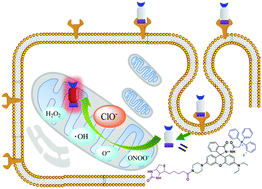
Chem. Commun., 2017,53, 5539-5541
https://doi.org/10.1039/C7CC01679D
A novel colorimetric assay for α-methylacyl-CoA racemase 1A (AMACR; P504S) utilizing the elimination of 2,4-dinitrophenolate
A versatile continuous colorimetric assay for AMACR is reported.
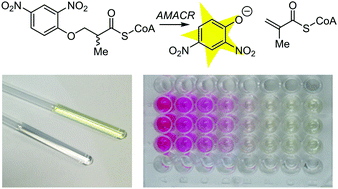
Chem. Commun., 2017,53, 5087-5090
https://doi.org/10.1039/C7CC00476A
A two-photon fluorescent probe for specific detection of hydrogen sulfide based on a familiar ESIPT fluorophore bearing AIE characteristics
A two-photon fluorescent probe based on an ESIPT fluorophore bearing AIE characteristics was utilized to detect H2S.
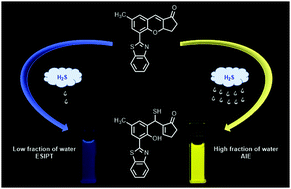
Chem. Commun., 2017,53, 4791-4794
https://doi.org/10.1039/C7CC01695F
End-to-end assembly and disassembly of gold nanorods based on photo-responsive host–guest interaction
The end-to-end assembly and disassembly of gold nanorods were realized via HS-β-CD recognition and controllable by both UV light irradiation and guest competition.

Chem. Commun., 2017,53, 4577-4580
https://doi.org/10.1039/C7CC01678F
A self-assembled amphiphilic imidazolium-based ATP probe
An amphiphilic imidazolium-based self-assembled probe forms aggregates and selectively recognizes aqueous ATP among other bioactive anions with a significant enhancement in fluorescence emission.
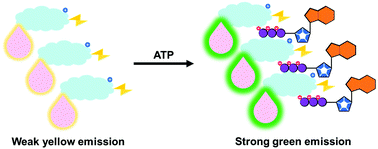
Chem. Commun., 2017,53, 4342-4345
https://doi.org/10.1039/C7CC01346A
Graphene oxide-enhanced cytoskeleton imaging and mitosis tracking
Graphene oxide enhances the imaging ability of a cell-impermeable peptide probe that targets microtubules, enabling the dynamic tracking of mitosis in live cells.
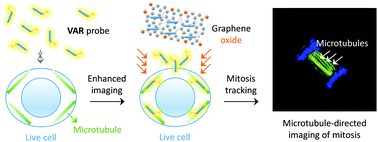
Chem. Commun., 2017,53, 3373-3376
https://doi.org/10.1039/C7CC01019B
Anion sensing with a Lewis acidic BODIPY-antimony(V) derivative
Modification of a BODIPY dye with a Lewis acidic antimony group affords a fluorescent fluoride and cyanide sensor.
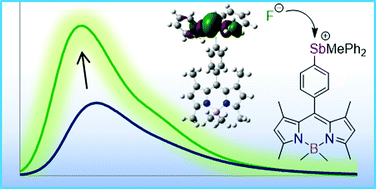
Chem. Commun., 2017,53, 2471-2474
https://doi.org/10.1039/C6CC09205E
Glucose selective bis-boronic acid click-fluor
Four novel bis-boronic acid compounds were synthesised via copper catalysed azide–alkyne cycloaddition (CuAAC) reactions.
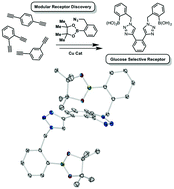
Chem. Commun., 2017,53, 2218-2221
https://doi.org/10.1039/C6CC08534B
Targeted tumor detection: guidelines for developing biotinylated diagnostics
We highlight the prominent role of hydrophilicity in the preferential cellular uptake process of biotinylated fluorescent probes.

Chem. Commun., 2017,53, 2154-2157
https://doi.org/10.1039/C7CC00311K
The Bull–James assembly as a chiral auxiliary and shift reagent in kinetic resolution of alkyne amines by the CuAAC reaction
The Bull–James boronic acid assembly is used simultaneously as a chiral auxiliary for kinetic resolution and as a chiral shift reagent for in situ enantiomeric excess (ee) determination by 1H NMR spectroscopy.
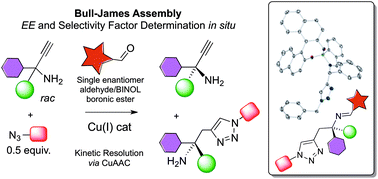
Org. Biomol. Chem., 2016,14, 10778-10782
https://doi.org/10.1039/C6OB01623E
A fluorescent activatable probe for imaging intracellular Mg2+
An BODIPY probe for detection and imaging of Mg2+ without interference from Ca2+ is described.

Org. Biomol. Chem., 2018,16, 239-244
https://doi.org/10.1039/C7OB02965A
A fluorescent combinatorial logic gate with Na+, H+-enabled OR and H+-driven low-medium-high ternary logic functions
A fluorescent combinatorial Na+, H+ logic gate is demonstrated that could represent a class of probes for investigating antiporters in biological systems.
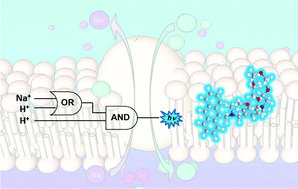
Org. Biomol. Chem., 2017,15, 10116-10121
https://doi.org/10.1039/C7OB01828B
Differential array sensing for cancer cell classification and novelty detection
A series of semi-specific peptides reported in the literature to bind various epitopes on cell surfaces were used in a differential sensing array to pattern cell line identity.
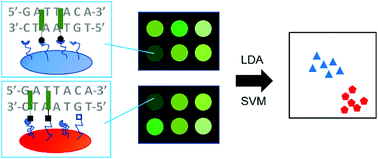
Org. Biomol. Chem., 2017,15, 9866-9874
https://doi.org/10.1039/C7OB02174G
Selective recognition of biologically important anions using a diblock polyfluorene–polythiophene conjugated polyelectrolyte
Fluorescence detection of nucleotide phosphates with a polyfluorene–polythiophene diblock copolymer is demonstrated, accompanied by determination of the sensor mechanism.
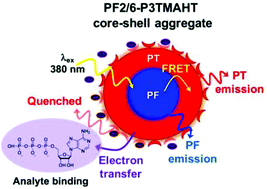
Polym. Chem., 2017,8, 7151-7159
https://doi.org/10.1039/C7PY01478C
Boronic acid recognition of non-interacting carbohydrates for biomedical applications: increasing fluorescence signals of minimally interacting aldoses and sucralose
To address carbohydrates that are commonly used in biomedical applications with low binding affinities for boronic acid based detection systems, two chemical modification methods were utilized to increase sensitivity.
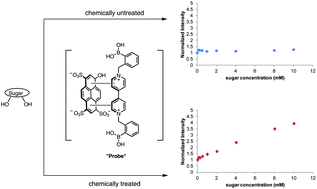
Org. Biomol. Chem., 2017,15, 9727-9733
https://doi.org/10.1039/C7OB01893B
Unpicking the determinants of amide NH⋯O![[double bond, length as m-dash]](https://www.rsc.org/images/entities/char_e001.gif) C hydrogen bond strength with diphenylacetylene molecular balances
C hydrogen bond strength with diphenylacetylene molecular balances
The stereoelectronic properties affecting hydrogen bond strength are investigated with a series of diphenylacetylene-based molecular balances.
![Graphical abstract: Unpicking the determinants of amide NH⋯O [[double bond, length as m-dash]] C hydrogen bond strength with diphenylacetylene molecular balances](/en/Image/Get?imageInfo.ImageType=GA&imageInfo.ImageIdentifier.ManuscriptID=C7OB02026K&imageInfo.ImageIdentifier.Year=2017)
Org. Biomol. Chem., 2017,15, 9156-9163
https://doi.org/10.1039/C7OB02026K
Control of electrostatic interaction between a molecular beacon aptamer and conjugated polyelectrolyte for detection range-tunable ATP assay
A new strategy is suggested to fine-tune the detection range by controlling the ionic density of CPEs in the MBA/CPE-based ATP assay.
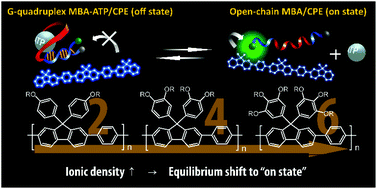
Polym. Chem., 2017,8, 6329-6334
https://doi.org/10.1039/C7PY01252G
A fluorescein-based chemosensor for relay fluorescence recognition of Cu(II) ions and biothiols in water and its applications to a molecular logic gate and living cell imaging
Relay recognition of copper(II) ions and biothiols via a fluorescence “on–off–on” cascade has been realized in 100% aqueous solution when excited by the visible light.
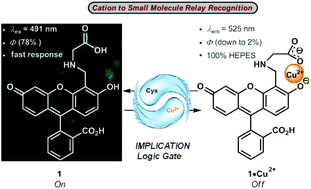
Org. Biomol. Chem., 2017,15, 4115-4121
https://doi.org/10.1039/C7OB00525C
Reaction-based indicator displacement assay (RIA) for the colorimetric and fluorometric detection of hydrogen peroxide
Reaction-based indicator displacement assay for the optical cycle-monitoring of hydrogen peroxide.
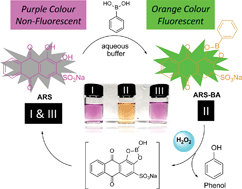
Org. Chem. Front., 2017,4, 1058-1062
https://doi.org/10.1039/C6QO00448B
Low-dimensional materials facilitate the conjugation between fluorogenic boronic acids and saccharides
We show that low-dimensional materials enhance the conjugation between fluorogenic phenylboronic acids and saccharides.

Mater. Chem. Front., 2017,1, 61-64
https://doi.org/10.1039/C6QM00158K
About this collection
Find out more about Tony Czarnik and AP de Silva and read our interviews with them.